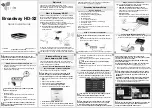
S T A R G e n 2 R e c e i v e r U s e r ’ s G u i d e
Page 10 of 47
DEVICE NAME, DEVICE LOCATION, DEVICE CONTACT, and DEVICE INFO 1-12: enter additional
information which will be visible at the WELCOME page of the WEB GUI. This information can be a link to
another website.
DEVICE MANUAL LINK: this link to a server can be defined to point to a manual. The link button MANUAL will
be found on the menu bar when a link is defined.
Link
Examples are: file://///server/share/path, ftp://server/file,
ftps://server/file, http://sitelink, https://sitelink.
Input
There are 2 input sources: SAT-IN (which is a satellite L-Band signal) and IP-IN (a Transport Stream over IP
input). A factory installed optional ASI input is also available, and is set up under Menu: DVB-TS> INPUT.
SAT-IN
Different types of outdoor LNBs are supported. For easy setup, the Local Oscillator (LO) frequency can be
entered. However, when the STAR receiver is used with Netmanager control the LO frequency needs to be set
to 0 KHz, and all receiver frequencies need to be entered in the L-band range only.
NCC = Network Control Channel, which contains the network control data generated by IDC’s Netmanager2.
Polarization in the Ca
rrier definition menu’s are only available when the LNB mode is set to “Universal”.
The preferred carrier setting is useful when a transition to a carrier is needed. This function is also supported
and controlled by NCC. If only one Carrier setting is r
equired the Prefered can be set to “Carrier A (or B) only.











































